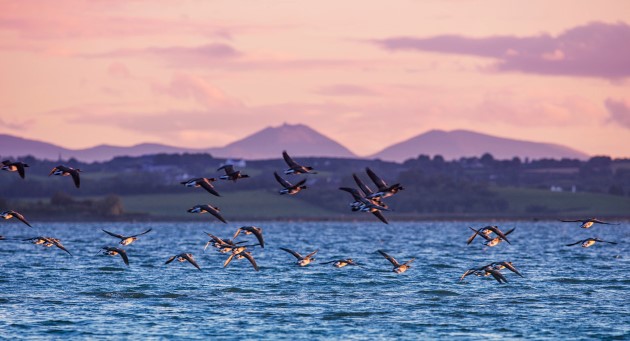Strangford Lough

Twice every day 400 million tons of water rushes up the Strangford lough through the deep seething strait, and down again into the Irish Sea. When the wind is in the east and the tide is ebbing, the bar is a very dangerous place. Here the tide runs at 6 miles an hour with the exception of the River Tagus in Portugal this is the fastest in Europe. The name the Norsemen gave it was the Strong Ford….the violent inlet is most appropriate. The Irish had previously named it Lough Cuan, the harbor lake. Not always were the waters of the lough as peaceful as they are today. The long oars of the strong Viking galleys on the Norsemen swept up against the swift tides churning on countless occasions their dark waters into white foam, these Vikings or faired strangers in olden times and the names they gave to some of the places around its shores are the names that are on them today. Portavogie, for example, means the guard gate of the lough. Sketrick Island is another place where the conquered Irish paid their scat, to tribute to the Norsemen. There was no getting off the Scat or Scott free with the Norsemen.
The Upper end towards Newtownards is shallow and the extensive banks exposed at low water are a feeding ground for innumerable wildfowl. In October the light bellied Brent Geese drop like Harriet jump-jets to settle on the shoreline of the lough and are a most welcoming sight in the lough. They fly thousands of miles from their summer breeding grounds in the Arctic. They have about 100 days there in which to mate and rear a family before setting out once again on the long journey back to this island. The endurance power of these birds is truly phenomenal. The flight from their Irish wintering grounds to Greenland is 12 hours nonstop, including an 8,000 feet climb to cross the vast Greenland ice cap. Since they leave these shores in the first days of May they will have completed a 9,000-mile return migration flight, braving hunters, predators and stormy weather. By mid-October, the geese community on the lough will have been boosted to around 12,000 birds, which is approximately 75% of Ireland’s seasonal population.
The Brent is the smallest and darkest of migrating geese with a blackhead breast and back. It is similar in size to a mallard duck but more upright and with a longer neck. The gregarious Brent’s feed along the tide lines and mudflats on vegetation such as algae and salt marsh plants. They may be also seen upending after Eelgrass on the bottom. The sight and sound of drooping flocks in loose formation honking their messages to their compatriots already on the ground is a thrilling experience. Suddenly the air above parts with a rushing sound as in sweeps a mighty train of birds like gliding aircraft seeking a perfect landing.
J.J Tohill
If you enjoyed this blog, click here to view more from us!
With Happy Ireland Productions, you can preserve your memories to last forever. Visit one of our partners to drop off your assortment of tapes, film, pictures and audio keepsakes. You’ll receive your DVD or digital copy with the original. Simple and Safe!
Your memories are priceless so why risk losing them.
Learn more about Happy Ireland Productions or Contact us for any inquiries